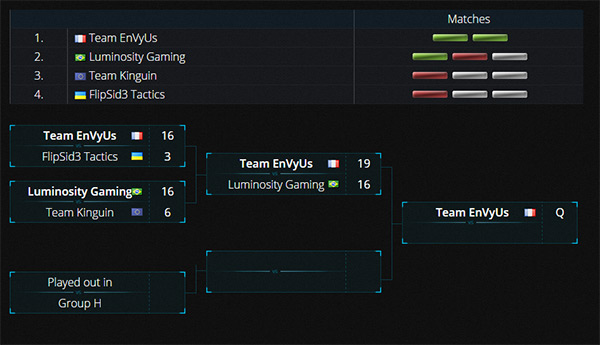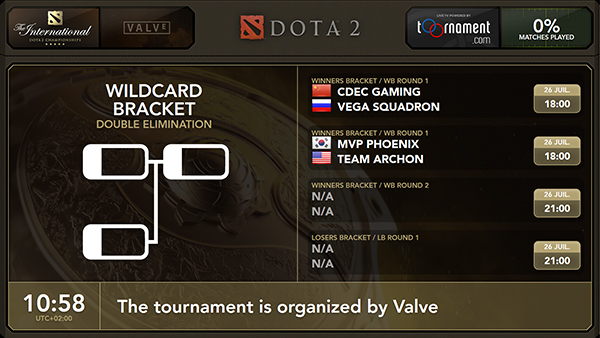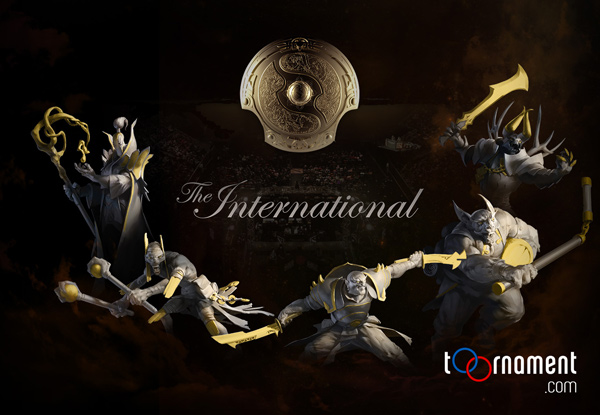This week end saw some epic performances from teams and players, we covered the main ones, here are the scores and details:
2015 WCS Season 3 Premier League
ESL ESEA Pro League Invitational
Follow our lastest announcements, technical updates, cases studies & tips
This week end saw some epic performances from teams and players, we covered the main ones, here are the scores and details:
2015 WCS Season 3 Premier League
ESL ESEA Pro League Invitational
As tournament formats and structures are our little hobby, we started analysing the major Esport events and the reasons behind their choices.
After The International 5, here we are, breaking down the LCS Finals and the recent ESL One Cologne 2015.
We hope you’ll find good inspiration or cautionary tales for your own tournaments!
The Group stage follows a “Round Robin”, “Home – Away” Best-of-1 format. It looks like a Best-of-2, but the each participants won’t play their opponent twice in a row.
We like this approach, as it provides more variety in each day’s match-ups and allows some time for the “revenge hype” to build up.
Following the Group Stage, eight teams advance to the Knockout Stage (formerly known as the Bracket Stage) and matchups transition to Best-of-5s. The Knockout Stage is comprised of Quarterfinals, Semifinals, and Finals.

The main change this year comes from a draw phase between the Group stage and the Knockout stage.
Riot wanted to give more transparency and avoid “throws”, where a team loses a game on purpose to avoid another team in the knockout bracket. The bracket draw will be broadcasted Live after all the Group stage matches are played, so that no one is be able to predict its future opponent.
Randomness is used here as a firewall against deceptive performances which hurt teams’ credibility and cast a shadow over the rest of the tournament.
After the unique format used at IEM Gamescom, ESL continues to explore alternatives to the classic “group-to-bracket” format. For this Summer ESL One, the German organization has come up with yet another twist in their structure. Here’s an excerpt from their announcement:
“We start the event with 4 groups of 4 teams each. Each group contains 2 legendary teams and 2 challenger teams. The teams will fight it out in a double elimination best-of-1 format per group with a small twist. The top 2 of each group will qualify for the playoffs.
The twist comes at the end of the first day of matches:
On the first day, all 4 groups will be played out up to and including the winners match, with the elimination match and deciding match still to be played out. This means that 4 teams will have qualified for the quarter finals and everyone else still has a chance to make it that far.
At the end of day 1, we will redraw the groups and seed the quarterfinals ensuring that a team cannot face off against a team that they have faced off against before until they reach the grand finals. After this swap, the teams will continue their run through the groups against their new opponents and try to reach a spot in the quarter finals.”
In a nutshell:
1. Groupstage is a Double Elimination brackets with 4 teams.
2. Semi finals are played, Winners Finals are played. The winner of this match qualifies for the Knockout Stage.
3. The three remaining teams from each group are shuffled with teams from other groups, but keep their current position.
4. In the new groups, Losers match is played, then Losers finals are played. The winner qualifies of this match qualifies for the Knockout Stage.
The main motivation behind this move is to prevent a team from being beaten twice by the same opponent. Still, it doesn’t look like it’s a fairer solution, as the original groups are supposed to be balanced from the start, with top seed teams and two low seed teams.

But our main concern on this option is the audience: Bracket Groups are already quite peculiar – although very interesting, but stacking a redraw right in the middle might be excessive.

Instead of playing games in a group of 4, we’ll play the 3 first games in a group of 4, then shuffle, then play the 3 remaining matches in a new group of 3. Still with us?
We then think about the participants. ESL CS tournaments are already criticized for using a Best-of-1 match format in the group stage, considered by many as not suitable for Counter-Strike. This FPS metagame is heavily influenced by the different maps and its ban/draft system.
Adding the group redraw hurts the relevance of the results, as naysayers will always have room to complain and post many “what if…” post-tournament articles and tweets.
The ESL One Cologne 2015 tournament format ultimately received mixed feedbacks for its Best-of-1 Match format in the group stage and GSL Groups redrawn. The next major tournament for ESL will be held in Dubai for the ESEA Invitational and we wonder which format they’ll come up with.
This week end saw 4 major tournaments on 3 games around the globe: Cologne welcomed the major CS:GO tournament ESL One. Meanwhile, League Of Legends was holding its Summer Split Finals both in Stockholm and New York. Hearthstone was the focus in Busan, as the OGN Masters Korea reached the Season 3 Finals.

All event were packed with fans filling entire stadiums, a nice sight for Esports growth.
We covered all those major events and you can find the scores, details and VODs below:
2015 NA LCS Summer Split Finals
The International, the most anticipated Dota 2 event of the year, is about to begin. As all the Dota champions and lucky fans will be gathered in Seattle, “pubstomps” around the world will broadcast the $17M tournament, so that Esport fans can watch the matches and have a nice beer.
If you happen to host a pubstomp, we have good news for you!

As our team covers all the tournament from July 26 to August 8, our Toornament TV solution will be up and ready. Quick reminder: Toornament TV is our smart, automated solution to display all the latest results, scores and schedules, photos and twitter feed.
We’ve even designed a special skin for The International 5, so that your pubtomp’s screen perfectly fits in the atmosphere. Of course, our “The International 5” Toornament TV, is completely free to use and share. So feel free to get it and enhance your pubstomp experience!
This year Dota 2 largest tournament is poised to be the largest tournament in Esport history. With a jaw-dropping $17M prize money, heavy logistics and all the best teams in the world, the 5th installment of Valve’s own Esport event looks better than ever.

It will also be a long run effort for all participants, as the tournament will follow 3 different steps over a record span of 14 days!
We will cover 100% of the matches and provide you with all results, scores, stats, stream and VODs links. Enjoy !
WILD CARD
Toornament Widget for the Wild Card tournament. Feel free to share and embed it everywhere!
Get the embed code and the customisation options here: https://www.toornament.com/tournaments/55ae20d8140ba0ef608b485d/
GROUP STAGE
MAIN EVENT
Toornament Widget for the Group stage and Main Event tournaments. Feel free to share and embed it everywhere!
Get the embed code and the customisation options here: https://www.toornament.com/tournaments/5559ebda150ba0be7c8b4569/